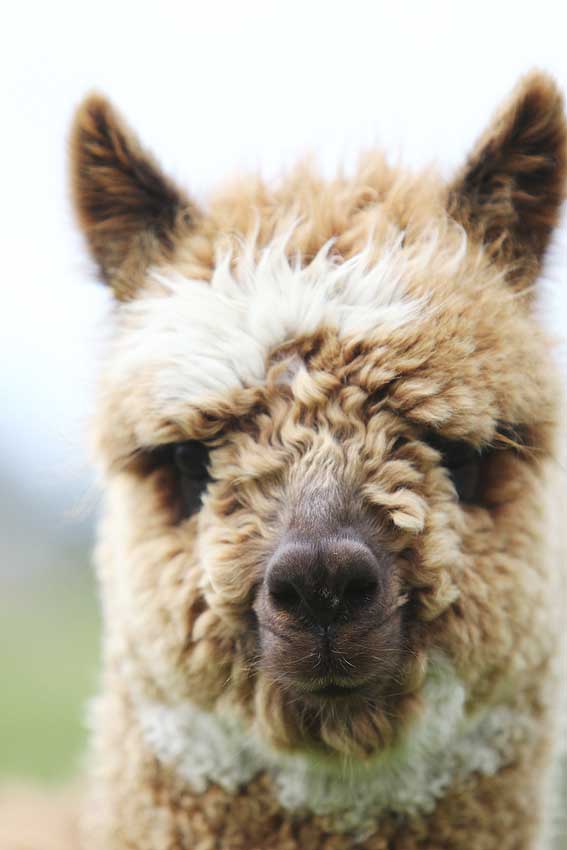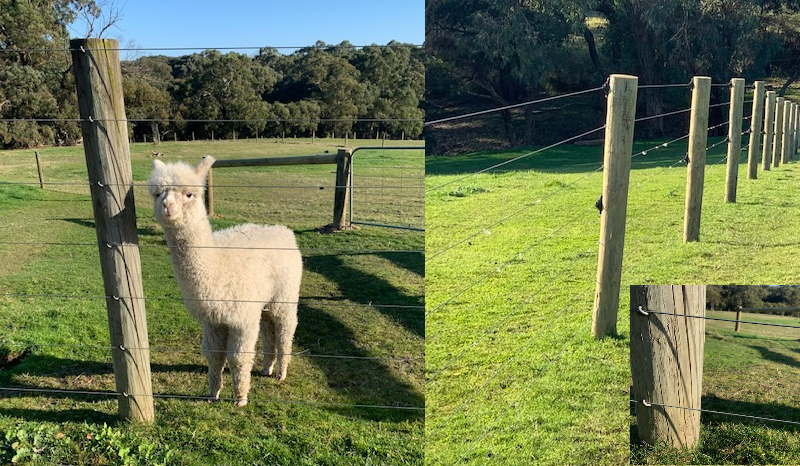
Alpacas are a member of the camelid family which also includes llamas and, as the name suggests, camels. There are two types of alpacas; Huacaya and Suri. We breed Huacaya.
![]()
 Countries of Origin – Peru, Bolivia, and Chile; first imported into Australia in 1858.
Countries of Origin – Peru, Bolivia, and Chile; first imported into Australia in 1858.
Size – A mature alpaca weighs 60 to 100kg and is 85 to 95cm tall at withers (top of the front shoulder).
Crias normally weigh 6 to 8kg kg at birth.
Lifespan – 15 to 20 years, with some living to 25
years of age.
Reproductive lifespan of females – Approximately 2 to
17 years.
Reproductive lifespan of males – Approximately 3 to
16 years.
Gestation – 11 to 12 months. Healthy females can produce cria approximately once each year. Single births are the norm with twins reported once in 50,000 births.
Colors – There are more than 22 natural shades of alpaca fleece ranging from white to black.
Fleece annual growth rate – 80 to 150 mm.
Weight of fleece – A junior (first fleece) is often about 1.5kg. Some mature individuals can yield
up to 8kg.
![]()
1. When do you mate alpaca?
Female alpacas are induced ovulators. This means that they do not have a specific season. They have a 12-14 day cycle and therefore pregnancies can result at any time of the year. In Australia the majority of mating takes place in Spring and Autumn.
2. Can I have just one alpaca?
Alpacas are herd animals and are instinctively gregarious. They feel secure and content when with other alpacas.
3. Can I run alpacas with other livestock? Herd Guards?
Yes alpacas can bond well with other types of animals and are often used as herd guards for sheep, goats and chickens. If you would like to read more we would be pleased to forward you a copy of the Australian Alpaca Association’s Alpaca Note 6 “Alpacas as Herd Protectors”.
Due to the risk of the alpacas being kicked you will need to be careful if mixing with horses and cattle. We run our males alpacas with two horses and there have been no problems.
4. Do alpacas spit?
Yes spitting is one of the few defence mechanisms an alpaca has and as you can imagine it is a very effective deterrent. They spit regurgitated or recently chewed grass and it brushes off when dry. The odour is distinctive and does not smell pleasant so best to avoid being the target. Alpacas spit at each other as a pecking order mechanism and it is rare that they spit directly at people.
5. Do alpacas kick or bite?
Alpacas are usually sensitive around the hind legs and will instinctively kick backwards if they sense a threat from the rear.
The alpaca foot is a soft pad and hence injuries from kicking are minimal. Most alpacas can be desensitized to being touched around the hind legs if they receive good handling as youngsters.
Alpacas rarely bite, if biting does occur it is generally done as attention seeking behaviour by
spoilt pets.
6. What do alpacas eat?
Alpacas are principally grazers but sometimes they enjoy casual browsing. They are fastidious food selectors that are highly adapted to eat small amounts of a variety of plants.
Although they can survive very harsh conditions, alpacas do best on good quality pasture and benefit from having access to plant material with long fibres: eg. hay.
There are a number of commercial alpaca mixes available but these are best thought of as supplying vitamins and minerals rather than the bulk feed which is obtained through grazing.
One important rule to remember is to introduce any changes to the diet gradually, over a period of a couple of weeks. This way, the microbes in the gut have time to adjust to any feed changes.
Some gardens contain a number of plants that are toxic to most livestock (oleander, rhododendron, laburnum etc). Care should be taken when fencing off gardens that such plants do not overhang into alpaca areas. Likewise, there is a long history of calamities with other livestock that have inadvertently been fed prunings from such plants. Local nurseries can provide good advice on poisonous plants or alternately click on the following link Poisonous Plant List
Although some people think alpacas don’t drink huge amounts, they do need to have ready access to good quality, fresh drinking water.
7. Health and Husbandry.
Below are links to further reading provided by the Australian Alpaca Association. In April 2020 we started our own You Tube channel – Auravale Alpacas You Tube channel We will be posting short videos on alpaca care over the next several months, we hope you find them helpful.
8. How often do you need to shear an alpaca?
Alpacas are shorn once a year, usually in spring. Shearing is the biggest maintenance required and usually takes around five to ten minutes per animal for an experienced alpaca shearer. If you are purchasing your first alpacas, ask the vendors for the name of a recommended shearer, or ask if you can bring the alpacas back to the property on their shearing day. Most AAA regions hold regular workshops and demonstrations on shearing alpacas. A very small percentage of alpacas are shorn standing up, but the preferred method of shearing is to lie the animals on their side and restrain their legs with a tether at each end. This protects both the shearer and the alpaca from being accidentally cut. One side of the animal is shorn and it is then rolled over and shorn on the other side. Depending on the density of the fleece, alpacas cut anywhere between 1 1/2 and 4 kg of fleece. Some of the high quality stud males will cut higher weights.
9. How do you transport alpaca?
Alpacas travel very well in a van, covered trailer or horse float. Most alpacas will sit during the journey and travel best in the company of another alpaca. On long trips over two or three hours it is advisable to plan for a stop so the alpacas can have a toilet break. Clean hay on the floor of the vehicle helps to absorb jarring on rough roads and also provides feed for the journey.
10. What fencing is best for alpacas?
Alpacas are gentle on fences but if the grass is greener on the other side then they will try to reach it. We find single strand wire, tightly strung is sufficient to keep our alpacas from escaping but it is important the bottom wire is no more than 10 cm from the ground. Barbed wire is unnecessary and can cause harm. Chicken wire is an option as is ringlock. Permanent electric fence is generally safe but unnecessary. Temporary electric fence should be avoided unless animals are being supervised.

11. Which water trough do I choose?
There are many different options for water troughs, we have found the alpacas use the larger ones that sit on the ground as a bath as well as drinking from it. This is not ideal as alpacas stand in poop then transfer that to the water, contaminating it for all. We do have some larger black plastic and converted bathtubs but we always cover up the majority of the top to prevent them from sticking their feet in. This also acts as a good safety feature around birthing time – as we have had a newborn cria stumble into a trough and drown. The smaller post/rail mounted ones work well and prevents the alpacas from contaminating the water. Placing the water troughs off the ground also assists in easy drainage. Troughs do get dirty and require cleaning, it is far easier to drain and refill rather than having to bucket or pump water out – a plug makes life much easier.

12. Feed buckets and hay feeders?
So many options! Below is just a few. Any container that keeps the feed dry and off the ground is suitable. Do avoid horse hay nets, as alpacas can get their ear tags and sometimes their heads caught with dire consequences. Wet hay is not healthy due to the growth of mold, so ensure your hay is kept dry at all times. If this is not possible only put enough hay out that will be eaten that day and replace as required.

13. Yards and restraining
If you have more than 3 or 4 alpacas handling them easily and safely can be improved by investing in portable yards and a race. Portable yards are versatile and can easily be reconfigured to whatever design is needed. Eg holding yards, lane ways, mating pens, temporary grazing, husbandry etc.
We have our portable yards set up in a wooden floored shed but they can be just as easily used outside.
We have portable scales set up in the race section so each time the alpacas go through they are weighed. We find this is an ideal way of keeping a close eye on the health of our animals. Health checks and administration of oral or injection medications can be administered whilst in the race.
Alpacas quickly get use to going through the race especially if there is some nice feed on the other side.
13. Do alpacas need shelters?
Alpacas similar to other livestock need shelter from heat and cold. Often a band of trees provide the necessary shelter for them for most of the year but immediately following shearing additional care is required. We find shelters are very helpful, especially during the 6-8 weeks following shearing when our alpacas are more susceptible to cold, wet and windy weather. Our paddock sheds not only provide shelter during this post shearing time but also provides shelter from the sun in summer and provides a clean and dry place to feed our alpacas. Other benefits of shelters are they provide a clean dry area for husbandry, vet visits and shearing.
Shelters come in all sorts of sizes and designs, below is an example of our paddock sheds. When positioning your shed try to locate the openings away from the prevailing winds, have it close for easy access for yourself, vets and shearer, have a gate so you can lock your alpacas in if required. By locating the shed between two paddocks access can be provided from two sides.
A trench around the outside perimeter should be sufficient to keep the shed dry in most cases. If you cannot keep your shed floor dry other flooring alternatives need to be investigated. Alpacas do not like small enclosed spaces, so ensure there is plenty of head room. One or two sheets of laser light allows additional light through without too much heat.











